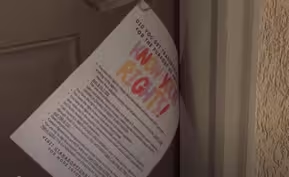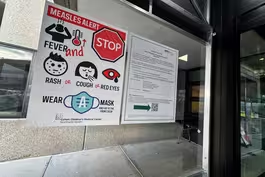
Why plans for a warning system fell apart in Kerr County
Clip: 7/10/2025 | 6m 12sVideo has Closed Captions
Plans for a flood warning system fell apart in Kerr County, leaving it vulnerable
The search for bodies continued nearly a week after deadly flooding in Texas. With 121 people confirmed dead and at least 161 still missing, officials there are facing scrutiny. The National Weather Service issued several watches and warnings before midnight on July 3, but local officials appeared unaware of the catastrophe until later in the morning. Amna Nawaz discussed more with Neena Satija.
Problems playing video? | Closed Captioning Feedback
Problems playing video? | Closed Captioning Feedback
Major corporate funding for the PBS News Hour is provided by BDO, BNSF, Consumer Cellular, American Cruise Lines, and Raymond James. Funding for the PBS NewsHour Weekend is provided by...

Why plans for a warning system fell apart in Kerr County
Clip: 7/10/2025 | 6m 12sVideo has Closed Captions
The search for bodies continued nearly a week after deadly flooding in Texas. With 121 people confirmed dead and at least 161 still missing, officials there are facing scrutiny. The National Weather Service issued several watches and warnings before midnight on July 3, but local officials appeared unaware of the catastrophe until later in the morning. Amna Nawaz discussed more with Neena Satija.
Problems playing video? | Closed Captioning Feedback
How to Watch PBS News Hour
PBS News Hour is available to stream on pbs.org and the free PBS App, available on iPhone, Apple TV, Android TV, Android smartphones, Amazon Fire TV, Amazon Fire Tablet, Roku, Samsung Smart TV, and Vizio.
Providing Support for PBS.org
Learn Moreabout PBS online sponsorshipAMNA NAWAZ: Welcome to the "News Hour."
The search for bodies continued in South Central Texas today almost a week after torrential rains triggered deadly flash floods; 121 people have been confirmed dead.
At least 161 remain missing.
Now officials are facing scrutiny about whether they gave sufficient notice about the rising waters.
The National Weather Service did issue several watches and warnings starting just before midnight on July 3.
At 1:14 a.m. on July 4, it pushed its first alert to cell phones in the area, warning of -- quote -- "dangerous and life-threatening flash floods."
Several more followed as the river surged over 30 feet in a matter of hours.
In the meantime, local officials appeared unaware of the unfolding catastrophe until later in the morning.
And there are now reports that Kerr County officials waited some 90 minutes to send phone alerts on a private system known as CodeRed after a firefighter requested it.
For a closer look, we're joined now by Neena Satija, an investigative reporter with The Houston Chronicle.
Neena, welcome to the "News Hour."
Thanks for joining us.
NEENA SATIJA, Investigative Reporter, The Houston Chronicle: Thank you for having me.
AMNA NAWAZ: So your reporting found that, nearly a decade before this July 4 flooding, there were local officials in Kerr County pushing to buy a new early flood warning system.
Tell us why they were pushing for that and where those efforts went.
NEENA SATIJA: So, Kerr County started talking about this about a year after there were devastating floods in Wimberley.
That's another town in the heart of the Texas Hill Country.
They had very devastating floods in 2015, killed more than a dozen people, similar kind of situation that we're hearing about right now.
Water rose, I think, 40 feet in just one hour during that flood.
And so the year after, Kerr County said, hey, we have got a similar problem here.
We're also in the Hill Country called Flash Flood Alley.
What can we do?
And what they realized was that the system they had in place was pretty old, pretty outdated.
You really had to go and look online as an emergency management official to see what water levels were.
There were only six gauges on the Guadalupe River in Kerr County, which is not very many.
And there were different low-water crossings, low-level roads and bridges that were monitored by two different agencies.
So they really wanted to update all of that.
And that was their goal as they talked about having a new flood warning system.
AMNA NAWAZ: So what exactly were they asking for from state officials?
And what was the response?
NEENA SATIJA: Well, they wanted help paying a million for this new system.
And so what they did is, they went to state officials and they said, hey, we know there's some federal disaster relief money, first from the floods in 2015, next from Hurricane Harvey.
Can we get a piece of that?
Because we can't fund this million dollar system on their own -- on our own.
And, essentially, they were told no a couple of times.
Then they went to the state for some state funding, and they were told, we can give you a zero percent interest loan, we can pay a small portion of it, but that's about it.
So they really weren't able to get very far in requesting state funding for help on this project.
AMNA NAWAZ: So we should note now, after these last week's deadly floods, that Texas Lieutenant Governor Dan Patrick has said in an interview earlier this week on Monday that lives could have been saved had there been a more robust warning system in place.
And he also said that the state will now pay for it.
Take a listen.
LT. GOV.
DAN PATRICK (R-TX): Had we had sirens along this area up and down, the same type of sirens that they have in Israel when there's an attack coming that would have blown very loudly, it's possible that that would have saved some of these lives.
And so if the city can't afford it, then the state will step up.
And we need to have these in place by the next summer.
AMNA NAWAZ: Neena, there is a special legislative session that's coming up later this month in Texas.
Do you see Texas lawmakers making a different decision now than they did the many times before Kerr County officials wanted to put this system into place and asked for that funding?
NEENA SATIJA: I think it's very possible they will.
We have never seen a disaster like this happen so close to a legislative session.
Usually, the session only meets six months out of every two years.
On the other hand, I think the big question is, what is it?
What is the system they're going to pay for?
Is it just sirens?
The experts we have talked to say it's not just about the sirens blaring.
It's about having enough gauges in the river, having enough monitoring stations to inform those sirens to say, this is when you really need to get out, this is how high the water is going to get.
So it's a pretty sophisticated system that you really need.
And the question is, how much are state officials willing to pay?
I would also note that local officials in Kerr County did not want sirens.
They actually decided as part of their plan they were trying to get funding for that they didn't want to include sirens.
So I think a lot of questions -- a lot of unanswered questions about what exactly the state will pay for, what local communities are going to ask, and how much money the state decides they're willing to front for all of this.
It's going to be not just a million for Kerr County, but I think you could get into much higher numbers when you're talking about other communities and having the best system you possibly can.
AMNA NAWAZ: It is worth noting as well that Texas leads the nation when it comes to flood deaths.
That Wimberley flooding you mentioned, some 13 people were killed and that, 89 killed after Hurricane Harvey.
Those are just a few of the deadly floods that you have seen in the last few years in Texas.
In your conversations with officials who were involved in those early asks and people today, what is it that's most needed on the ground?
Is there consensus around that?
NEENA SATIJA: That's a really good question.
I think more data is key, I think having more of these high-tech monitors that can transmit data in real time, and also to -- in a way that the public can understand, that's a huge, huge improvement.
And there are places in Texas that have been able to implement that.
But I also think that it really is time to have a conversation about, should we be in these areas?
Should we be in these floodways and these floodplains?
Do we need to be continuing to develop there?
I think a lot of experts are saying, that's where we need to go.
We need to stop developing in some of these extremely flood-prone areas.
And that's a tough conversation to have.
AMNA NAWAZ: Neena Satija, investigative reporter with The Houston Chronicle, thank you so much for joining us.
We appreciate your time.
NEENA SATIJA: Thank you.
Agencies accused of rushing adoptions before moms backed out
Video has Closed Captions
Clip: 7/10/2025 | 8m 55s | Agencies accused of rushing adoptions before mothers can change their minds (8m 55s)
Jan. 6 prosecutor says pardons send 'dangerous message'
Video has Closed Captions
Clip: 7/10/2025 | 7m 42s | LAW & JUSTICE (7m 42s)
Measles cases surge to highest levels in over 30 years
Video has Closed Captions
Clip: 7/10/2025 | 5m 39s | Measles cases surge to highest levels in over 30 years, CDC data shows (5m 39s)
News Wrap: Judge blocks order to end birthright citizenship
Video has Closed Captions
Clip: 7/10/2025 | 7m 10s | News Wrap: Federal judge blocks Trump order to end birthright citizenship (7m 10s)
Opera uses AI to give non-verbal people a voice
Video has Closed Captions
Clip: 7/10/2025 | 9m 20s | Opera uses AI to give people with non-verbal disabilities a voice (9m 20s)
Union says fight continues against federal employee firings
Video has Closed Captions
Clip: 7/10/2025 | 7m 1s | Federal workers union says it will continue to fight firings after Supreme Court ruling (7m 1s)
Providing Support for PBS.org
Learn Moreabout PBS online sponsorshipSupport for PBS provided by:
Major corporate funding for the PBS News Hour is provided by BDO, BNSF, Consumer Cellular, American Cruise Lines, and Raymond James. Funding for the PBS NewsHour Weekend is provided by...

















